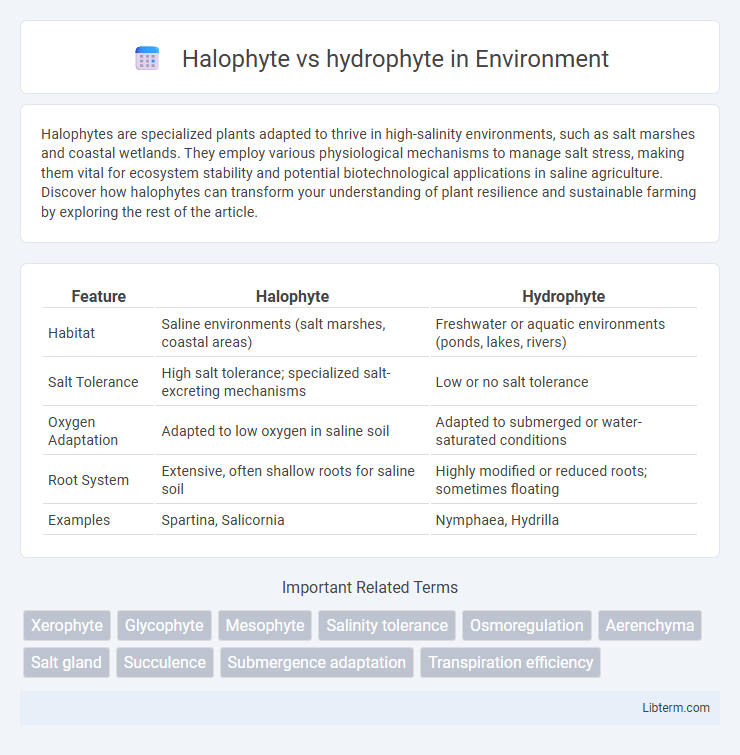Halophytes are specialized plants adapted to thrive in high-salinity environments, such as salt marshes and coastal wetlands. They employ various physiological mechanisms to manage salt stress, making them vital for ecosystem stability and potential biotechnological applications in saline agriculture. Discover how halophytes can transform your understanding of plant resilience and sustainable farming by exploring the rest of the article.
Table of Comparison
| Feature | Halophyte | Hydrophyte |
|---|---|---|
| Habitat | Saline environments (salt marshes, coastal areas) | Freshwater or aquatic environments (ponds, lakes, rivers) |
| Salt Tolerance | High salt tolerance; specialized salt-excreting mechanisms | Low or no salt tolerance |
| Oxygen Adaptation | Adapted to low oxygen in saline soil | Adapted to submerged or water-saturated conditions |
| Root System | Extensive, often shallow roots for saline soil | Highly modified or reduced roots; sometimes floating |
| Examples | Spartina, Salicornia | Nymphaea, Hydrilla |
Introduction to Halophytes and Hydrophytes
Halophytes are specialized plants adapted to thrive in high-salinity environments such as salt marshes, coastal areas, and saline soils, exhibiting unique physiological mechanisms like salt excretion and succulence. Hydrophytes, on the other hand, are aquatic plants found in freshwater or marine habitats, characterized by adaptations such as aerenchyma tissue for buoyancy and gas exchange in water. Both plant types play crucial roles in their ecosystems by stabilizing habitats, supporting biodiversity, and contributing to nutrient cycling in saline and aquatic environments respectively.
Basic Definitions and Key Differences
Halophytes are salt-tolerant plants adapted to grow in high-salinity environments such as salt marshes and coastal areas, while hydrophytes thrive in aquatic habitats like ponds and wetlands with abundant water. Halophytes possess specialized salt-excreting glands and succulent leaves to manage salt stress, whereas hydrophytes exhibit adaptations like air-filled tissues (aerenchyma) and thin cuticles to facilitate oxygen transport and water uptake. The primary distinction lies in halophytes' ability to tolerate saline conditions versus hydrophytes' adaptation to submerged or water-saturated environments.
Morphological Adaptations in Halophytes
Halophytes exhibit specialized morphological adaptations such as succulent leaves that store water, thick cuticles to reduce transpiration, and salt glands or bladders that excrete excess salt, enabling survival in high-salinity environments. In contrast, hydrophytes possess features like thin cuticles, large air spaces (aerenchyma) for buoyancy, and extensive root systems to absorb oxygen in aquatic habitats. These distinct adaptations highlight the evolutionary responses of halophytes to saline conditions versus hydrophytes' morphological specialization for water-rich ecosystems.
Morphological Adaptations in Hydrophytes
Hydrophytes exhibit specialized morphological adaptations such as aerenchyma tissue, which facilitates oxygen transport to submerged roots, and thin, flexible leaves that minimize resistance in aquatic environments. Their stomata are often located on the upper surface, optimizing gas exchange when floating on water surfaces. Additionally, reduced or absent cuticles and extensive root systems enhance water absorption and stability in aquatic habitats.
Physiological Mechanisms in Salt Tolerance
Halophytes possess specialized physiological mechanisms such as ion compartmentalization within vacuoles, synthesis of compatible solutes like proline, and efficient salt secretion through salt glands to maintain cellular homeostasis under high salinity. Hydrophytes typically lack these salt-specific adaptations and instead rely on waterlogged conditions with low salt concentrations, exhibiting less active salt regulation mechanisms. The presence of selective ion channels and enhanced antioxidative enzyme activity in halophytes further supports their superior salt tolerance compared to hydrophytes.
Water Management Strategies in Hydrophytes
Hydrophytes employ specialized water management strategies such as aerenchyma tissue formation to facilitate oxygen transport in aquatic environments, and thin or absent cuticles to enhance water absorption. Their stomatal distribution often adapts to submerged or floating conditions, allowing efficient gas exchange and preventing water loss. These adaptations enable hydrophytes to thrive in water-saturated habitats by optimizing water uptake and respiratory functions.
Ecological Niches and Habitats
Halophytes thrive in saline environments such as coastal marshes, salt flats, and mangrove swamps, exhibiting specialized adaptations to high salt concentrations and water scarcity. Hydrophytes occupy freshwater habitats like ponds, lakes, rivers, and wetlands, relying on abundant water availability and often displaying adaptations for buoyancy and submerged growth. The distinct ecological niches of halophytes and hydrophytes reflect their evolutionary specialization to saline versus freshwater ecosystems, influencing biodiversity and ecosystem dynamics.
Examples of Halophyte and Hydrophyte Species
Examples of halophyte species include Salicornia, Spartina, and Atriplex, which thrive in high-salinity environments such as salt marshes and coastal regions. Hydrophyte species like Nymphaea (water lilies), Typha (cattails), and Eichhornia (water hyacinth) are adapted to live in aquatic habitats including freshwater lakes, ponds, and wetlands. These examples illustrate the specialized adaptations of halophytes to saline soils and hydrophytes to submerged or floating water conditions.
Importance in Agriculture and Environmental Conservation
Halophytes are salt-tolerant plants essential for reclaiming saline soils and enhancing agricultural productivity in coastal and arid regions, while hydrophytes thrive in aquatic environments, contributing to water purification and supporting biodiversity. Their unique adaptations allow halophytes to prevent soil salinization and hydrophytes to maintain wetland ecosystems, crucial for carbon sequestration and flood control. Integrating both plant types into environmental management strategies promotes sustainable agriculture and resilience against climate change impacts.
Conclusion: Comparing Halophytes and Hydrophytes
Halophytes thrive in high-salinity environments, employing specialized salt-excretion mechanisms and succulent tissues to survive, whereas hydrophytes are adapted to aquatic or water-saturated habitats featuring aerenchyma tissues for buoyancy and gas exchange. Both plant types exhibit unique morphological and physiological traits that enable survival under extreme environmental conditions, highlighting remarkable evolutionary adaptations. Understanding these mechanisms offers insights into plant resilience and potential applications in agriculture and ecosystem management.
Halophyte Infographic

 libterm.com
libterm.com